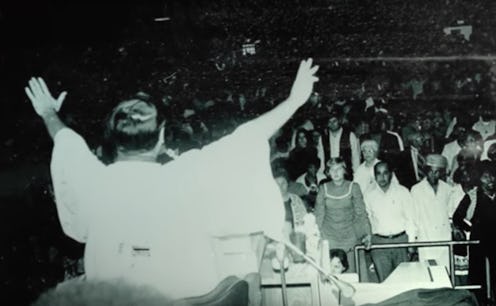Entertainment
Why Fringe Religious Leader Jim Jones Chose This Remote Site For His Infamous Compound

A&E’s new documentary special Jonestown: The Women Behind The Massacre premieres Feb. 26 and focuses on the women who stood behind prophet leader Jim Jones. On Nov. 18, 1978, the mass murder-suicide of members of the Peoples Temple fringe religious group became the biggest American loss of life in a non-natural event, and this record remained until the Sept. 11 attacks, as reported by Rolling Stone. What happened at this compound is equal parts harrowing and mind-blowing, but where was Jonestown actually located?
James Warren “Jim” Jones founded the Peoples Temple of the Disciples of Christ, more commonly known as the Peoples Temple, in the mid-1950s in his home state of Indiana, as reported by The New York Times. History.com notes that it wasn’t long before Jones moved his teachings to northern California, and soon, he began to pick up steam and plenty of members. Jones had no theological training, per Britannica, and wasn’t even affiliated with a denomination at the time of his founding. According to the Times, Jones believed that moving his clan — about 100 people by the mid-to-late 1960s — to the outskirts of San Francisco would save him and then from an impending nuclear holocaust. As Jones acclaim grew, so did the number of his followers. They believed he could read minds, and he practiced faith healing.
The Peoples Temple seemed progressive — they were only of the only integrated churches at the time, which was a selling point — but their humanitarian appearance was masking something darker. Survivors claimed to ABC News that Jones controlled, abused, and blackmailed his members, with some former members describing how they were forced to swear loyalty to Jones and were forbidden to criticize him. Per Rolling Stone, media coverage of Jones became increasingly unflattering. So he decided in 1977 that he and his followers should move to the South American country of Guyana and make their own utopia. Though remote, Guyana was a good choice because, freed from Britain’s rule in 1966, it is the only South American country in which English is the official state language. It would be easy to communicate and to gain more members. And moving to Guyana demonstrated a form of commitment.
This movement made the American government increasingly nervous, because Jones pretty much had free reign of American citizens in a foreign country. In November 1978, as reported by Slate, U.S Congressman Leo Ryan visited the Peoples Temple compound in Guyana to ensure that members weren’t being held their against their will. On Nov. 18, Ryan, his crew, and some defecting members of Peoples Temple, set to head back to the States, were ambushed by Peoples Temple members. According to The Huffington Post, five people — including Ryan and three NBC journalists — were killed.
Shortly after, also per HuffPo, Jones reportedly ordered the cult’s suicide pact be enacted, which entailed members drinking a fruit-flavored drink spiked with cyanide and a sedative. It was injected into the mouths of children and babies before adults took their dosage. Out of nearly 1000 people, only 100 survived, a majority of whom had either already left the compound or just happened to be in the Guyanese capital of Georgetown that day, away from Jonestown. Jones died of a gunshot wound to the head, according to the Huffington Post.
Though some think that Jonestown was an act of mass suicide, others consider it murder. According to Rolling Stone, Tim Reiterman, a reporter for the San Francisco Examiner who was with Congressman Ryan’s plane and survived the attack, said, "Jones put all the pieces in place for a last act of self-destruction, then gave the order to kill the children first, sealing everyone's fate."
While there’s no way to truly know why Jones chose Guyana as the place for Jonestown, the New York Times reported that Jones had called Jonestown "a socialist utopia where all races could mix in peace and work for the common good." But "after he arrived in Guyana, he increasingly preached about dark forces that were out to shut down his experiment in communal living," the article continued. It was far from the utopia Jones claimed it would be. Leslie Wagner-Wilson escaped Jonestown the morning of the tragedy, tying her son to her back with a bed sheet and hiking through the jungle. She told VICE:
"Those who tout Jonestown as idyllic spent the majority of their time in Georgetown with running water, a refrigerator… a toilet that flushed and were able to roam the city. Their experience was different… the ones that continue to push the myth that Jonestown was beautiful... were complicit. We were starving, but [Jones] was cashing the social security checks of African Americans… he had millions of dollars hidden away, and our children were malnourished. People were manipulated and fooled into turning over houses, businesses… After all, if you have given everything, what would you return to the [US] with?"
As reported by the East Bay Times, over 400 bodies of Jonestown victims were unclaimed, and today, they are buried in an unmarked mass grave in Oakland, California. Though the grounds of Jonestown were far from U.S. soil, hundreds of Americans died in their chosen South American home.
If you or someone you know are experiencing suicidal thoughts, call 911, or call the National Suicide Prevention Hotline at 1-800-273-8255.